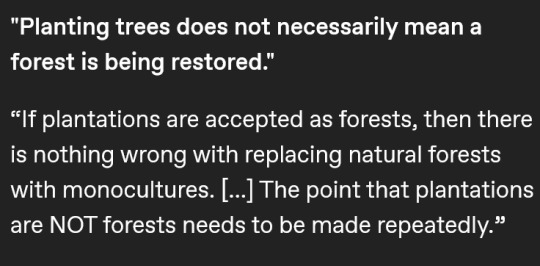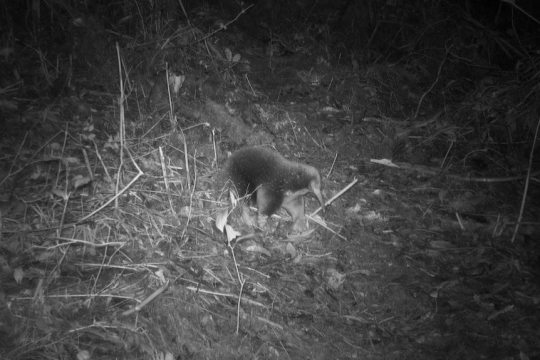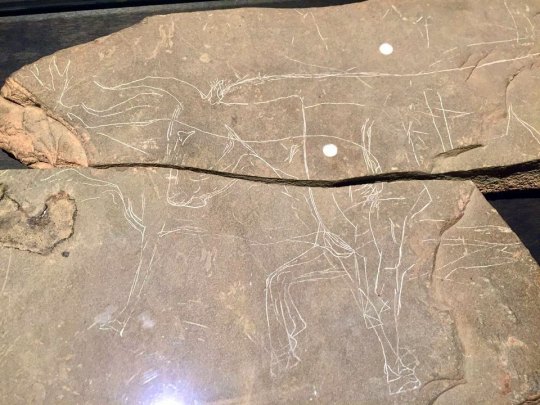#80% biodiversity
Explore tagged Tumblr posts
Text

4 notes
·
View notes
Text
#ayo guys !!!#so you might not know bc it isn’t really getting reported on from what i’ve seen#a brazillian politician signed a bill to take tons of the land in the amazon away from the indigenous people that live there#people who protect like 80% of the world’s biodiversity#and leave it up for grabs for environmentally destructive industries like logging#read about it. sign this. be informed of news that could heavily impact the environment and the people who live there#i just realized i don’t do that all too often. and i want to do that more. so i’m starting today.
1 note
·
View note
Text
"At nearly 150 acres, the Jardim Gramacho landfill in Rio de Janeiro was one of the largest and most infamous in all of Latin America. Now it’s a mangrove forest teeming with life.
Decommissioned 11 years ago, between 1970 and 2012 the dump, bordering Rio’s famous Guanabara Bay, received 80 million metric tonnes of trash from the area’s Gramacho neighborhood.
Now, a public-private partnership led by the Rio Municipal Cleaning Company has returned the area to nature, specifically mangroves, one of the most valuable of all ecosystems.
Planting 24 acres of mangroves at a time, today the forest stretches out more than 120 acres and is the largest mangrove area of the bay.
“Before, we polluted the bay and the rivers. Now, it’s the bay and the rivers that pollute us,” a lead official on the project told Africa News. “Today, the mangrove has completely recovered.”
Other organizations have taken action to restore mangroves along the bay as well. The non-profit Ocean Pact funded the Green Guanabara Bay Project which successfully restored 12.5 hectares or around 25 acres of mangroves.
According to some estimates, 1 acre of mangrove forests can store more carbon in roots and soil than 4 acres of even the most biodiverse rainforest, making them paramount to any world climate mitigation strategy.
Furthermore, their impressive lattice work of roots and insane durability means that storm surges impacting mangroves lose about 66% of their kinetic energy without even destroying the trees.
Lastly, coastal fishing communities, in [four] words, cannot exist without mangroves. They act as nurseries and perfect habitat for all kinds of fish and crustaceans that small-scale fishermen rely on for their daily bread."
-via Good News Network, 7/31/23
youtube
-video via Africanews, July 26, 2023
#brazil#mangrove#mangrove forest#fishing#tropical storms#hurricanes#storm surge#pollution#landfill#garbage#rio de janeiro#guanabara bay#Youtube
2K notes
·
View notes
Text

Despite its green image, Ireland has surprisingly little forest. [...] [M]ore than 80% of the island of Ireland was [once] covered in trees. [...] [O]f that 11% of the Republic of Ireland that is [now] forested, the vast majority (9% of the country) is planted with [non-native] spruces like the Sitka spruce [in commercial plantations], a fast growing conifer originally from Alaska which can be harvested after just 15 years. Just 2% of Ireland is covered with native broadleaf trees.
Text by: Martha O’Hagan Luff. “Ireland has lost almost all of its native forests - here’s how to bring them back.” The Conversation. 24 February 2023. [Emphasis added.]
---
[I]ndustrial [...] oil palm plantations [...] have proliferated in tropical regions in many parts of the world, often built at the expense of mangrove and humid forest lands, with the aim to transform them from 'worthless swamp' to agro-industrial complexes [...]. Another clear case [...] comes from the southernmost area in the Colombian Pacific [...]. Here, since the early 1980s, the forest has been destroyed and communities displaced to give way to oil palm plantations. Inexistent in the 1970s, by the mid-1990s they had expanded to over 30,000 hectares. The monotony of the plantation - row after row of palm as far as you can see, a green desert of sorts - replaced the diverse, heterogenous and entangled world of forest and communities.
Text by: Arturo Escobar. "Thinking-Feeling with the Earth: Territorial Struggles and the Ontological Dimension of the Epistemologies of the South." Revista de Antropologia Iberoamericana Volume 11 Issue 1. 2016. [Emphasis added.]
---
But efforts to increase global tree cover to limit climate change have skewed towards erecting plantations of fast-growing trees [...] [because] planting trees can demonstrate results a lot quicker than natural forest restoration. [...] [But] ill-advised tree planting can unleash invasive species [...]. [In India] [t]o maximize how much timber these forests yielded, British foresters planted pines from Europe and North America in extensive plantations in the Himalayan region [...] and introduced acacia trees from Australia [...]. One of these species, wattle (Acacia mearnsii) [...] was planted in [...] the Western Ghats. This area is what scientists all a biodiversity hotspot – a globally rare ecosystem replete with species. Wattle has since become invasive and taken over much of the region’s mountainous grasslands. Similarly, pine has spread over much of the Himalayas and displaced native oak trees while teak has replaced sal, a native hardwood, in central India. Both oak and sal are valued for [...] fertiliser, medicine and oil. Their loss [...] impoverished many [local and Indigenous people]. [...]
India’s national forest policy [...] aims for trees on 33% of the country’s area. Schemes under this policy include plantations consisting of a single species such as eucalyptus or bamboo which grow fast and can increase tree cover quickly, demonstrating success according to this dubious measure. Sometimes these trees are planted in grasslands and other ecosystems where tree cover is naturally low. [...] The success of forest restoration efforts cannot be measured by tree cover alone. The Indian government’s definition of “forest” still encompasses plantations of a single tree species, orchards and even bamboo, which actually belongs to the grass family. This means that biennial forest surveys cannot quantify how much natural forest has been restored, or convey the consequences of displacing native trees with competitive plantation species or identify if these exotic trees have invaded natural grasslands which have then been falsely recorded as restored forests. [...] Planting trees does not necessarily mean a forest is being restored. And reviving ecosystems in which trees are scarce is important too.
Text by: Dhanapal Govindarajulu. "India was a tree planting laboratory for 200 years - here are the results." The Conversation. 10 August 2023. [Emphasis added.]
---
Nations and companies are competing to appropriate the last piece of available “untapped” forest that can provide the most amount of “environmental services.” [...] When British Empire forestry was first established as a disciplinary practice in India, [...] it proscribed private interests and initiated a new system of forest management based on a logic of utilitarian [extraction] [...]. Rather than the actual survival of plants or animals, the goal of this forestry was focused on preventing the exhaustion of resource extraction. [...]
Text by: Daniel Fernandez and Alon Schwabe. "The Offsetted." e-flux Architecture (Positions). November 2013. [Emphasis added.]
---
At first glance, the statistics tell a hopeful story: Chile’s forests are expanding. […] On the ground, however, a different scene plays out: monocultures have replaced diverse natural forests [...]. At the crux of these [...] narratives is the definition of a single word: “forest.” [...] Pinochet’s wave of [...] [laws] included Forest Ordinance 701, passed in 1974, which subsidized the expansion of tree plantations [...] and gave the National Forestry Corporation control of Mapuche lands. This law set in motion an enormous expansion in fiber-farms, which are vast expanses of monoculture plantations Pinus radiata and Eucalyptus species grown for paper manufacturing and timber. [T]hese new plantations replaced native forests […]. According to a recent study in Landscape and Urban Planning, timber plantations expanded by a factor of ten from 1975 to 2007, and now occupy 43 percent of the South-central Chilean landscape. [...] While the confusion surrounding the definition of “forest” may appear to be an issue of semantics, Dr. Francis Putz [...] warns otherwise in a recent review published in Biotropica. […] Monoculture plantations are optimized for a single product, whereas native forests offer [...] water regulation, hosting biodiversity, and building soil fertility. [...][A]ccording to Putz, the distinction between plantations and native forests needs to be made clear. “[...] [A]nd the point that plantations are NOT forests needs to be made repeatedly [...]."
Text by: Julian Moll-Rocek. “When forests aren’t really forests: the high cost of Chile’s tree plantations.” Mongabay. 18 August 2014. [Emphasis added.]
#abolition#ecology#imperial#colonial#landscape#haunted#indigenous#multispecies#interspecies#temporality#carceral geography#plantations#ecologies#tidalectics#intimacies of four continents#archipelagic thinking#caribbean
2K notes
·
View notes
Text


The way most people talk about climate change we are led to believe we all have an equal part in creating the capitalist nightmare we live in, but that’s a lie. The unsustainable and extractive nature of capitalism grew directly from the ideological and material foundations of European colonization. We cannot hold the entire human species responsible for that. It’s victim blaming.
The vast majority of waste is produced by the same people and institutions who hold power. Fighting for our planet, the health of our land, our food, our homes, our communities, is where the fight against capitalism and white supremacy collide. Any fight for environmental justice must also be a fight for racial justice because BI&POC are the ones who disproportionately bear the weight of climate change.
White Settler Colonialism Is Destroying the Planet, Not Poor BI&POC
Don’t believe the Malthusian and eco-fascist myth that there are too many people on the planet to care for. This is a lie peddled by capitalists, eugenicists, and people who advocate for genocide. We know that every landbase has its limit for how much life it can support (indigenous peoples have been saying this for hundreds of years), but “overpopulation” rhetoric is overwhelmingly used as a means to enforce colonial hierarchies where wealthy white people can maintain lives of access and privilege while poor BI&POC barely survive.
Instead of telling poor BI&POC to have less children or to stop wanting better lives, we should build a movement to fight climate change which centers racial justice, abolishes capitalism, and forces wealthy, predominately white populations to stop hoarding resources.
Here are some Earth Day facts for tomorrow so you don’t fall for the lies:
Just 100 companies are responsible for 71% of global emissions. (Source: the Guardian)
Black communities are exposed to 56% more pollution than is caused by their consumption. For Latinx communities, it is 63%. (Source: American Journal of Public Health)
97% of waste produced in the United States is corporate waste. 80% of businesses are owned & operated by white people. (Source: “The Story of Stuff” & US News)
Indigenous peoples make up less than 5% of the planet’s human population, yet they are protecting 80% of its biodiversity. (Source: National Geographic)
The world’s richest 10% produce half of carbon emissions while the poorest half contribute only 10%. (Source: Oxfam)
The world’s wealthiest 16% use 80% of the planet’s natural resources. (Source: CNN)
We are not all equally “responsible.” White settler colonialism and capitalism are destroying the planet, not poor BI&POC.
#climate change#climate crisis#white supremism#community building#practical anarchy#practical anarchism#anarchist society#practical#revolution#anarchism#daily posts#communism#anti capitalist#anti capitalism#late stage capitalism#organization#grassroots#grass roots#anarchists#libraries#leftism#social issues#economy#economics#climate#ecology#anarchy works#environmentalism#environment#solarpunk
173 notes
·
View notes
Text
Like. Fucking. Hell. Electricity can be a legitimately useful resource but we For Real do not need this much of it
There are so many ways of producing electricity that are dependent on like either damage that has already been done (hey fun fact didja know solar fields decommission panels after a certain number of years? they hit like 80-90% of their original efficency and get rotated out even tho they're still very much capable of working fine!) or are just actually pretty reasonable at SMALL scales (hydro with a little water wheel from a small pond on a big creek -> can even increase biodiversity so long as ur like, paying attention and not fucking migrations with how you build things, diverting small amounts of flow from an already downhill stream for a few dozen yards can be basically fine, there's also gravity pumps uphill catchment tiny water towers etc; these systems just work with magnets and rotation, it's municipal generation and larger scale dams that get Bad)
None Of These will power millions of peoples home microwaves and electric kettles and cars and lighting and industry and all that bullshit. But there's many many years worth of reclaiming all the toxic extracted shit to power like, medical equipment. Eventually these things will fall off too, break for the last time and not be able to be fixed generations from now, but that's a lot fucking better bet for ur gr8 gr8 grandkids than no complex life on earth!
Do not fall for the trap of collapsing imperial core luxury into needs. It's unhelpful and makes you look like a callous, whiny fool. Differentiate what you need from what youve become accustomed to demanding. The world is fucking chockablock with materials that shouldn't have been made in the first place but fucking exist now, we cant compost trillions of miles of copper power lines. Municipal scales kill. Your toaster oven is not a ventilator.
139 notes
·
View notes
Text

Biodiversity loss in agriculture is a pressing threat to global food systems, reducing our ability to cope with climate change, environmental degradation, and nutritional challenges. Over the past century, about 75% of plant genetic diversity has been lost as farmers have shifted toward high-yielding, genetically uniform crops. Today, just nine plant species account for 66% of global crop production, with rice, wheat, and maize alone providing more than 50% of the world’s plant-derived calories. This reliance on a narrow set of crops undermines food system resilience, leaving us vulnerable to pests, diseases, and climate extremes. It has also created a monocultural vulnerability reminiscent of the Irish potato famine of the 1840s, when reliance on a single, genetically uniform crop led to catastrophic losses due to disease. Genetic diversity within and among species acts as a natural buffer against environmental changes. Different crop varieties respond differently to stressors, providing farmers with options to manage risks. When one crop fails, others can compensate, helping to safeguard harvests and livelihoods. However, as the diversity on our farms diminishes, farmers have fewer tools to adapt to the growing volatility brought on by climate change. Extreme weather events such as droughts, floods, and heat waves are becoming more severe, and monocultures are ill-equipped to withstand these shocks. The environmental impact of current agricultural practices further exacerbates biodiversity loss. Agriculture is responsible for about 90% of global deforestation and contributes substantially to habitat destruction, driving the extinction of countless species. Excessive use of inorganic fertilizers and pesticides pollutes soils and waterways, disrupting ecosystems and degrading essential natural services such as pollination and soil fertility. Soil degradation now affects one-third of the world’s soils. In sub-Saharan Africa, agriculture is responsible for 80% of soil degradation on farmland, leading to reduced plant diversity because only the few species that can tolerate poor soil conditions survive. Moreover, the heavy use of nitrogen fertilizers and livestock manure, particularly in regions such as Asia and Latin America, has disrupted natural nitrogen cycles, contributing to greenhouse gas emissions such as nitrous oxide and methane. These emissions not only drive climate change but also accelerate biodiversity loss by reducing the resilience and health of ecosystems. The decline of agricultural biodiversity also impacts human health. Diets worldwide have become increasingly homogeneous, dominated by a few staple crops that are energy-rich but nutrient-poor. Less than 200 species currently contribute to global food supplies, and this lack of variety has serious health consequences. Low dietary diversity is now a leading driver of diet-related deaths, with about 11 million premature deaths annually linked to unhealthy diets. The decline in biodiversity means that fewer nutrient-rich foods such as fruits, vegetables, nuts, and seeds are available, exacerbating malnutrition in all its forms, from undernutrition to obesity.
10 October 2024
63 notes
·
View notes
Text
Wonderful news from the Cyclops Mountains of West Papua today with the rediscovery of Attenborough's long-beaked echidna (Zaglossus attenboroughi)!

(Image credit: Expedition Cyclops)
Previously known a single specimen collected in 1961, Attenborough's long-beaked echidna has long been one of the world's most elusive mammals. Recognised as a distinct species in 1998, an expedition to the Cyclops Mountains in 2007 failed to observe the echidna but found evidence of recent diggings and foraging activity which, alongside local knowledge, implied that the species still survived in those remote mountain forests.
Finally, just a few months ago, a new expedition into its remote mountain home by Expedition Cyclops caught the first ever footage of Attenborough's long-beaked echidna in the wild, which is also the first time it has been seen by scientists in over 60 years. In a remarkable stroke of luck, the echidna was captured on the last of over 80 camera traps on the final day of the trip!
Attenborough's long-beaked echidna is the most distinctive of the three species of long-beaked echidna thanks to its smaller size, shorter, straighter beak and reddish-brown fur. Its habits are virtually unknown, but its differently shaped beak may suggest that it differs in diet and feeding habits from the other two long-beaked echidna species. It appears to be endemic to the highest elevations of the Cyclops Mountains, which are steep, extremely rainy and treacherous to explore, hence why it remained hidden for so long.

(Image credit: Expedition Cyclops)
There are only five species of monotreme alive today, the sole living custodians of a lineage stretching back some 200 million years, and this makes each species extraordinarily valuable. Unfortunately, all three species of long-beaked echidna are threatened with extinction, with Attenborough's long-beaked echidna being classed as critically endangered. Losing any species is a tragedy, but for a group as small and precious as monotremes, any extinction would be especially disastrous.
Alongside the rediscovery of the echidna, Expedition Cyclops also made the first record of Mayr's honeyeater (Ptiloprora mayri) in 16 years and discovered dozens of new species of insects, arachnids, shrimp and frogs. Their work documenting the hidden biodiversity of the Cyclops Mountains is ongoing, so if you'd like to follow and support the expedition make sure to visit their website! https://www.expeditioncyclops.org/
#oceania#papua#west papua#new guinea#wildlife#mammal#mammals#monotreme#monotremes#echidna#echidnas#animal facts#animal news#mammalogy#natural history#my stuff
296 notes
·
View notes
Text

Beautiful Butterflies
These beautiful butterflies are from Plate 54 in Histoire Naturelle des Lépidoptères Exotiques (1835) by Pierre-Hippolyte Lucas (17 January 1814 – 5 July 1899). Lucas was a French entomologist, who worked at the Muséum National d’Histoire Naturelle.
Histoire Naturelle des Lépidoptères Exotiques was a serial publication in 20 parts that contains 80 hand-colored plates with descriptions and illustrations of non-European butterflies, including many species from South America, Australia, or Asia.
Plate 54 showcases 3 species of butterflies that are likely to be known currently as:
Scarce Bamboo Page, Philaethria dido
Lacewing butterfly, Cethosia lamarckii
Lacewing butterfly, Cethosia leschenaultii
View more beautiful plates from this work in Biodiversity Heritage Library‘s Flickr album. Smithsonian Libraries and Archives digitized this work for BHL and added it to their Flickr collection.
#histsciart#sciart#naturalhistory#biodiversity heritage library#smithsonian libraries#butterflies#lepidoptera
95 notes
·
View notes
Text
A bit about my adopted country, Ecuador
The Chocó Andino at latitude zero is 45 minutes from Quito. It's an area of 287,000 hectares with high biodiversity. There are different types of forests, an Andean bear corridor, 227 registered orchids and more than 600 species of birds, 80 of which are endemic.
In the forests are an abundance of orchids, bromeliads, heliconias and huicundos. There are trees that are more than 100 years old. It is estimated that each hectare of this forest absorbs 250 tons of carbon, so its conservation is of vital importance to the local people.
The Chocó is also the home of the olinguito, gallo de la peña, Andean bears, ocelots and an infinity of hummingbirds and insects. Chemical compounds extracted from the frog Epipedobates anthonyi are used to make epibatidine, a drug 200 times more powerful than morphine and that does not create addiction.
In recent years, this area has produced high quality cacao and coffee, which is being exported to the US and Europe. Throughout the area there are 124 lodging places with about 1,300 rooms available. Photo courtesy: El Comercio



27 notes
·
View notes
Text
climate change fatalism is so exhausting. it easily becomes a ecological scapegoat to blame instead of humans taking accountability for how their individual actions affect the environment.
i had a conversation earlier in a fb garden group where a women told me that since desertification was changing her local landscape and making it harder to grow native plants, it was actually okay and even good of her to be planting invasive exotic species that could adapt to the "new normal" climate in her area so that the wildlife would have at least something for shade/shelter/food. in the same message she mentioned trying to eradicate native weeds on their acreage because it had no personal use to her or her non-native livestock.
and i was like. no girl. the desertification in your area has been caused by decades of bad agricultural land management practices, something that is fully reversible. those weeds you are ripping out provide more benefit to wildlife than your nasty exotics, and ranchers removing these "undesirable" natives for decades is why the land has grown barren. planting invasive exotics to replace the artificial loss of biodiversity will only hasten the problem you seek to fix.
but the point of my post isn't this specific woman, it's the general attitude she represents. it's a lot easier to blame the nebulous figure of climate change than to work toward ecological restoration. it's simpler to plant invasive exotics than to reverse decades of poor land management. it's more enjoyable to grow a pretty flowering shrub and pretend it's necessary due to climate change than to allow native ragweed to grow even though the allergies suck because it feeds the birds and pollinators. and it's a helluva lot easier to blame climate change for the worsening of your local environment than to admit that overgrazing your livestock and ripping out native plants just because they have no immediate value to you might have contributed heavily to the decline of your microbiome.
climate change has quickly become this collective responsibility that no one individual is responsible for, because it's so easy to blame the slightest change in environment on it. "we're running out of water because of climate change!" it's because urban landscaping practices channel away water instead of letting it soak into the groundwater wells, and turf lawns use 80% of the city water. "the city is so much hotter now!" yeah because twenty years ago developers planted fast-growing but short-lived/weak trees which have now all died, meaning our roads and neighborhoods have way less shade and foliage to absorb the heat. "the bees are disappearing because of climate change!" sharon it's because there's not a single thing in your yard that a native pollinator would recognize as a food source.
anyways i don't know where exactly i'm going with this. i guess i'm just tired of climate change fatalism because it removes personal incentive to do anything to reverse environmental harm that we could be fixing on an individual level. but "global warming" has become a very convenient excuse for many people, unfortunately.
just makes me wonder how often things blamed on climate change are actually a result of direct human actions that are reversible
43 notes
·
View notes
Text
More than 80% of global land area needed to maintain human well-being and meet biodiversity targets is at risk of conflict with human development, according to a new study led by the Cornell Lab of Ornithology. The study, published Jan. 10 in Nature Communications, found that roughly half of global land, excluding Antarctica, provides nearly all current levels of nature's services to people while also conserving biodiversity for 27,000 species of birds, mammals, reptiles and amphibians. Of that, only 18% is adequately protected, the study found.
Continue Reading.
111 notes
·
View notes
Text
hey y'all, i made a science discord server! Biodiverse is a wonderful LGBT+ centered community to hang out and connect with other science lovers about our interests! anyone is welcome regardless of experience, whether you're a casual enjoyer of any field or a certified professional, we'd love to have you!
the server is mainly focused on natural sciences; there's channels for discussing a wide variety of topics, from zoology to astronomy and more. we have a "living thing of the day" segment which features interesting info about plants, animals, and fungi! trivia questions are also frequently hosted. we plan to host server events soon like streaming documentaries and vc study sessions!
below is the discord invite link for anyone interested. stop by and say hello! hope to see you there!
#its gonna be a lot of tags so#biology#botany#zoology#mycology#marine biology#ecology#astronomy#paleontology#vulture culture#biology discord server#science#geology#nature#inaturalist#conservation#animals#pets#veterinary#lgbt#lgbt server#idk what else to tag this as#join the server pwease its a fun time :]
198 notes
·
View notes
Text
"Discarded shells from restaurants and hotels are being used to restore damaged oyster ecosystems, promote biodiversity and lower pollution in the city’s bays...
Nestled in between the South China Sea and the Pearl River Delta, Hong Kong has been seen historically as an oyster hotspot. “They have been supporting our livelihood since ancient times,” says Anniqa Law Chung-kiu, a project manager at the Nature Conservancy (TNC) in Hong Kong. “Both oysters and their shells are treasures to humans.”
Over the past five decades, however, the city’s sprawling urban development, water pollution, as well as the over-harvesting and frequent seafloor dredging by the lime industry – which uses the crushed shells to make construction material – have destroyed Hong Kong’s oyster habitats and made the waters less hospitable for biodiversity.
The more oyster colonies falter, the worse the problem gets: oysters are filter feeders and purify water by gobbling up impurities. Just one Hong Kong oyster can filter up to 200 litres of water a day, more than any other known oyster species. But decades of rapid industrialisation have largely halted their water-purifying services.
The depletion of Hong Kong’s natural oyster reefs also affects the ability of local farmers to sustainably cultivate their oysters in a healthy environment, denting the reputation of the city’s 700-year oyster farming tradition, designated by Unesco as an “intangible cultural heritage”.
Inhabitants of the coast feel abandoned, says Ken Cheng Wai-kwan, the community leader of Ha Pak Nai on Hong Kong’s Deep Bay, facing the commercial city of Shenzhen in China. “This place is forgotten,” Cheng says. “Oysters have been rooted here for over 400 years. I ask the question: do we want to lose it, or not?”
A group of activists and scientists are taking up the challenge by collecting discarded oyster shells and recycling them to rebuild some of the reefs that have been destroyed and forgotten in the hope the oysters may make a comeback. They’ve selected locations around the island where data they’ve collected suggests ecosystems still have the potential to be rebooted, and there are still enough oyster larvae to recolonise and repopulate reefs. Ideally, this will have a positive effect on local biodiversity as a whole, and farming communities.
Farmers from Ha Pak Nai were among the first to hand over their discarded shells to the TNC team for recycling. Law’s team works with eight oyster farmers from Deep Bay to recycle up to 10 tonnes of shells every year [over 22,000 pounds]. They collect an average of 870kg every week [over 1,900 pounds] from 12 hotels, supermarkets, clubhouses and seafood restaurants in the city, including some of its most fashionable establishments. About 80 tonnes of shells [over 176,000 pounds] have been recycled since the project began in 2020.
Restaurants will soon be further incentivised to recycle the shells when Hong Kong introduces a new fee for waste removal – something that is routine in many countries, but only became law in Hong Kong in July and remains controversial...
Preliminary data shows some of the restored reefs have started to increase the levels of biodiversity, but more research is needed to determine to what extent they are contributing to the filtering of the water, says Law.
Scientists from the City University of Hong Kong are also looking to use oyster shells to increase biodiversity on the city’s concrete seawalls. They hope to provide tiny, wet shelter spots around the seawall in which organisms can find refuge during low tide.
“It’s a form of soft engineering, like a nature-based solution,” says Charlene Lai, a research assistant on the team."
-via The Guardian, December 22, 2023
#oyster#oyster farming#sea shells#seafood#hong kong#ecosystem restoration#biodiversity#ecosystem#water pollution#clean water#cultural heritage#marine life#marine animals#marine science#good news#hope
808 notes
·
View notes
Photo





🐂 This is the famous Chaleux stone, one of the biggest pieces of Belgian’s ‘portable art’ (that could be carried from place to place). The slab is part of our collections and exhibited in the Gallery of Humankind.🐂
It was found in the region of Dinant and dates back to 12,000 to 13,000 years ago, from the so-called Magdalenian culture. Think: end of the last glacial period, the extinction of mammoths and Lascaux and Altamira cave art. Portable art was the result of carving or engraving bone, antler, ivory or stone. Some examples, like the Chaleux stone, are the earliest traces of realism in art.
The object also gives us a glimpse of the biodiversity of that period. 🌿
The front side of the slab shows an auroch, an wild ancestor of our modern cattle. Aurochs were among the largest herbivores at that time: a shoulder height of up to 180 cm in bulls, and weighing up to 1300 kilos. It also had massive elongated and broad horns that reached 80 cm in length. This animal must have been an impressive sight! European aurochs went extinct a long time ago due to human activities: habitat loss and over-hunting.
Behind it you can see another animal, with antlers, that already roamed our regions during the Paleolithic : the forest reindeer. During prehistoric times, forest reindeers used to populate multiple regions across western Europe. Contrary to the aurochs, the species survived and is still found in smaller areas of Scandinavian and Karelian forests. 🦌🌲
On the other side of the stone: a wild horse, a standing ibex and one lying down. Can you spot them? 👀 We have scanned Belgian portable art so you can admire them in 3D: paleo-art.naturalsciences.be. There is even an anthropomorphic statuette (a Venus)!
https://paleo-art.naturalsciences.be/
[First picture by visitor @dis_oakenshield on Instagram]
#museum#museumvisitor#chaleuxstone#art#prehistoric art#dinant#belgium#archeology#history#portable art#prehistoric
317 notes
·
View notes